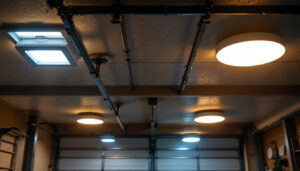

As a lighting contractor, understanding the nuances of ceiling-mounted light fixtures is crucial for delivering quality installations and ensuring customer satisfaction. This article outlines essential do’s and don’ts that can help streamline your work and enhance the overall effectiveness of your lighting projects.
Ceiling-mounted light fixtures are versatile lighting solutions that serve various purposes in residential and commercial spaces. They can be used to illuminate hallways, living rooms, kitchens, and offices, making them a staple in the lighting industry. Their installation requires a keen understanding of electrical systems, design aesthetics, and safety regulations.
Before diving into the specifics of installation, it’s essential to familiarize yourself with the different types of ceiling-mounted fixtures available. These include flush mounts, semi-flush mounts, and pendant lights, each offering unique benefits and design options. Understanding these differences will help you make informed choices tailored to your client’s needs.
Flush mount fixtures sit directly against the ceiling, providing a sleek appearance while maximizing headroom. They are ideal for rooms with low ceilings and offer a clean, unobtrusive look. Semi-flush mount fixtures hang slightly below the ceiling, adding a decorative element while still being practical for lower spaces. Pendant lights, on the other hand, can be suspended at various heights, making them perfect for creating focal points or adding layers of light in larger rooms.
In addition to these common types, there are also specialized ceiling-mounted fixtures designed for specific applications. For example, track lighting systems allow for adjustable light direction and can be tailored to highlight artwork or architectural features. Recessed lighting, often used in modern designs, provides a minimalist aesthetic by embedding fixtures into the ceiling, creating an unobtrusive source of illumination that blends seamlessly with the surroundings.
When installing ceiling-mounted fixtures, several factors must be taken into account. The height of the ceiling, the size of the room, and the intended use of the space all influence the choice of fixture and its placement. Additionally, understanding the electrical requirements, such as wattage and voltage, is crucial for ensuring safety and functionality.
Proper placement is essential for achieving the desired lighting effect. Consider the room’s layout and how light will be distributed. For instance, in a kitchen, task lighting over countertops may be necessary, while in a living room, ambient lighting may take precedence. Furthermore, the color temperature of the bulbs used can significantly impact the atmosphere of a space; warmer tones create a cozy environment, while cooler tones can enhance focus and productivity in work areas. It’s also worth noting that dimmable fixtures provide flexibility, allowing users to adjust lighting levels based on the time of day or activity, thereby enhancing the overall functionality of the space.
Successful installation of ceiling-mounted fixtures involves adhering to best practices that ensure safety, efficiency, and aesthetic appeal. Here are some do’s that every lighting contractor should keep in mind.
Before installation, conducting a comprehensive site assessment is vital. This involves evaluating the space, considering the existing electrical infrastructure, and identifying any potential obstacles. Understanding the client’s needs and preferences will also guide your decisions regarding fixture selection and placement.
Take measurements of the room and note the ceiling height. This information will help determine the appropriate type and size of the fixture. Additionally, consider the color scheme and decor style of the room to ensure the chosen fixture complements the overall aesthetic. For instance, in a modern minimalist space, sleek and simple fixtures may be more appropriate, while a vintage-themed room might benefit from ornate designs. Furthermore, consider the room’s purpose; a cozy reading nook might require softer lighting, while a kitchen may need brighter, more focused illumination.
Adhering to local electrical codes and safety standards is non-negotiable. These regulations are designed to protect both the contractor and the client from potential hazards. Ensure that all wiring is up to code, and use fixtures that are rated for the specific environment, especially in areas prone to moisture, such as kitchens and bathrooms.
Always turn off the power at the circuit breaker before starting any installation work. Use a voltage tester to confirm that the power is off, and follow proper safety protocols throughout the installation process. Additionally, consider using circuit breakers with GFCI (Ground Fault Circuit Interrupter) protection in areas where water exposure is a concern. This extra layer of safety can prevent electrical shocks and ensure peace of mind for both you and your clients.
With the growing emphasis on sustainability, considering energy-efficient lighting options is increasingly important. LED fixtures, for example, consume less energy and have a longer lifespan compared to traditional incandescent bulbs. This not only benefits the environment but also offers cost savings for clients in terms of energy bills.
When recommending fixtures, consider those with Energy Star ratings or other certifications that indicate energy efficiency. This will enhance your reputation as a knowledgeable contractor who prioritizes both quality and sustainability. Additionally, educate your clients about the benefits of smart lighting systems that can be controlled remotely or programmed to adjust based on the time of day. These systems not only provide convenience but also contribute to energy savings by ensuring that lights are only on when needed, further aligning with eco-friendly practices.
While there are many best practices to follow, there are also common pitfalls that contractors should avoid during the installation of ceiling-mounted fixtures. Here are some don’ts that can help prevent issues down the line.
Rushing through the installation can lead to mistakes that compromise safety and functionality. Take the time to ensure that all components are correctly installed and securely fastened. Double-check connections and make sure that the fixture is level before finalizing the installation.
Additionally, don’t overlook the importance of thorough testing after installation. Turn the power back on and test the fixture to ensure it operates correctly. This step is crucial for identifying any issues before leaving the job site.
While technical expertise is essential, understanding and respecting client preferences is equally important. Avoid imposing personal design choices on clients; instead, engage them in discussions about their vision for the space. This collaborative approach not only enhances client satisfaction but also fosters trust and builds lasting relationships.
Inquire about their preferred lighting styles, colors, and any specific features they desire. By incorporating their feedback into your recommendations, you can create a tailored lighting solution that meets their needs and exceeds their expectations.
Maintenance is a critical aspect of lighting installations that is often overlooked. When selecting fixtures, consider how easy they will be to clean and maintain. Fixtures that are difficult to access or require specialized cleaning can lead to frustration for clients down the line.
Provide clients with clear instructions on how to maintain their fixtures, including cleaning tips and recommendations for bulb replacement. This proactive approach demonstrates professionalism and care, ensuring that the lighting remains effective and visually appealing over time.
Even seasoned lighting contractors can make mistakes during the installation of ceiling-mounted fixtures. Recognizing these common errors can help ensure smoother projects and better outcomes for clients.
Choosing the wrong size fixture can significantly impact the room’s aesthetics and functionality. A fixture that is too small may not provide adequate lighting, while one that is too large can overwhelm the space. As a general rule, the diameter of the fixture should be about one-third the width of the room.
When in doubt, consult design guidelines or use online calculators to determine the ideal size for the space. This attention to detail can make a significant difference in the overall lighting design.
Wiring mistakes can lead to serious safety hazards, including electrical fires. Ensure that all connections are secure and properly insulated. Use wire nuts or electrical tape to cover exposed wires, and avoid overloading circuits by adhering to the manufacturer’s specifications.
If unsure about wiring techniques, consult with an experienced electrician or refer to the National Electrical Code for guidance. Prioritizing safety will protect both the contractor and the client.
Effective lighting design involves creating layers of light to achieve a balanced and inviting atmosphere. Relying solely on ceiling-mounted fixtures may result in harsh lighting that lacks depth. Consider incorporating other lighting types, such as wall sconces, table lamps, and accent lighting, to create a more dynamic and versatile lighting scheme.
Encourage clients to think about how they use the space and what activities will take place there. This understanding will help inform decisions about the types of fixtures and their placement, ultimately leading to a more satisfying lighting experience.
Installing ceiling-mounted light fixtures is a fundamental skill for lighting contractors that requires a blend of technical knowledge, design sensibility, and client engagement. By adhering to the do’s and don’ts outlined in this article, contractors can enhance their installations, ensuring safety, efficiency, and aesthetic appeal.
Ultimately, the goal is to create lighting solutions that not only meet the functional needs of the space but also elevate the overall design. By avoiding common pitfalls and prioritizing client satisfaction, contractors can build a solid reputation in the industry and foster long-term relationships with their clients.
As the lighting industry continues to evolve, staying informed about new technologies and trends will further enhance a contractor’s ability to deliver exceptional results. Embracing innovation while adhering to best practices will ensure success in the ever-changing landscape of lighting design and installation.
Ready to take your lighting installations to the next level? At LumenWholesale, we provide lighting contractors like you with the highest quality, spec-grade lighting products at prices that can’t be beaten. Say goodbye to local distributor markups and hello to our extensive selection that meets the most rigorous industry standards. With free shipping on bulk orders, you’ll enjoy the ultimate convenience without any hidden costs. Elevate your lighting solutions with the reliability and performance of LumenWholesale. Discover wholesale lighting at the best value and make your next project shine.

Discover the cost-effective strategies and expert insights from smart lighting contractors on replacing solar panels in lanterns.

Discover why LED light bulbs are revolutionizing the lighting industry and what every lighting contractor needs to know to stay ahead.

Discover how small hallway light fixtures can transform your space with effective lighting solutions.

Explore the essential insights every lighting contractor needs to know about recessed can lights.
Get notified when NEW deals are released.
Optimize your budget with wholesale discounts.
Only top-quality, specification-grade lighting products.
No additional costs at checkout - what you see is what you pay.
We understand the unique needs of contractors.